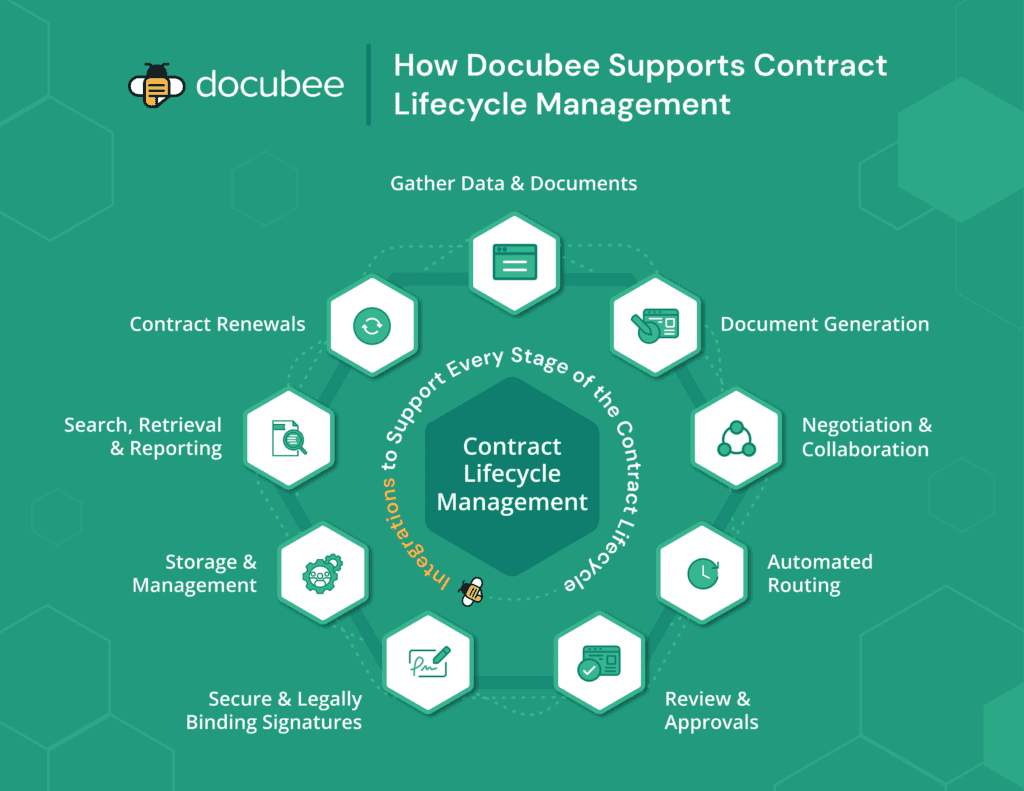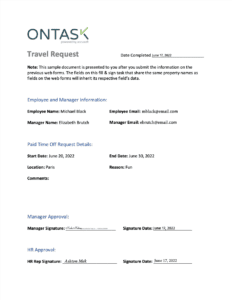Lack of visibility, silos across departments, slow turnaround times. Do these sound like things you associate with your contract management process?
Then it’s time to make a change.
Implementing contract management best practices into your workflows will eliminate inefficiencies. You know, annoyances like bottlenecks in your approval processes and long contract lifecycles. Because really, who has time for all of that?
Luckily for you, we’ve asked the experts on our team how to improve your contract lifecycle management, and have these tips and tools to help.
Top Benefits of Effective Contract Management

Why make your contract management process more efficient? It’s a no-brainer to want a better way to manage contract workflows.
But in case you’re wondering, look at the following benefits.
Streamlined Contract Process
An effective contract management workflow means you have the right processes and tools in place for better collaboration between employees and clients. For example, a single platform for sharing and accessing contracts and other essential documents removes the chaos of locating missing files.
The ability to share contracts with internal departments and external parties, and manage contract approval and completion is priceless. Especially with improvements you will see in customer satisfaction.
Streamlining your contract process creates a better experience for everyone involved, including your customers. Which is a great way to ensure they stay around for the long haul.
Better Transparency
Efficient contract management creates higher visibility. And that visibility creates transparency for contract management processes.
Seeing where a contract is and who’s next in line to view, approve, and sign keeps everyone informed and on the same page.
Increased Data Security & Compliance
Adding contract management software to your process can boost compliance.
Most businesses have specific compliances and regulations they must follow depending on their industry, which can be a serious headache. But, having the right tool in place keeps compliance a no-brainer by automating security.
Enhanced Cost-Savings
Poor contract management costs businesses roughly 9% of annual sales. For large businesses, this can create a major ding on your bottom line.
So simply put, improving the efficiency of your contract management means reduced chances for financial loss. For instance, you can see operating costs reduced by 10-30%. Plus, it can lower the overall cost of contracting by 2-11% of the contract’s value.
18 Contract Management Best Practices

Now that you know WHY you should care about optimizing contract management processes, it’s time to dive into how.
Here are 20 best practices contract managers should follow today.
1) Standardize Contract Templates
Recreating contracts from scratch each time is a time-consuming process. It’s inefficient and slows deal closings by days or weeks.
And, it’s unnecessary. Why start from scratch EVERY SINGLE TIME when you can start with a customizable template?
A standardized contract template saves time, and can majorly reduce errors on paperwork by laying the foundation of your process. Your best bet is to design documents with standard terms and conditions you can easily amend to fit customers’ needs.
2) Automate Manual Contract Management Processes
Manually tracking and managing contracts is a preventable bottleneck, with the right tools. Automating contract management lets you get to “yes” faster and more efficiently by eliminating the emails, and follow-ups that slow things down. Plus, your team and clients will thank you.
Contract management automation allows you to create, sign, send, and monitor where contracts are in the workflow. You can also set up notifications to remind you and team members to complete tasks holding up the line.
3) Maintain Strict Compliance
The last thing you need is to run into legal problems. Maintaining strict compliance for your contract management process:
- Mitigates risks and minimizes legal and financial penalties
- Ensures uniformity and fosters a culture of compliance
- Supports safe and ethical business operations
- Prevents revocation of licenses or certifications
- Safeguards the company’s reputation
- Promotes uniformity and compliance across the entire organization
- Provides program oversight
- Ensures employee understanding and adherence to compliance standards
To do this, ensure the tool you select keeps things like compliance top of mind, and implements new security standards as new regulations are released. If you end up switching to a new tool, be sure to add this to your list of questions during a demo.
4) Use Digital Signatures to Expedite Signing Processes
Waiting for handwritten signatures can majorly slow contract progress by weeks or even longer, especially when you use snail mail. Even when it comes to email attachments, that can lead to hardships in printing the document, scanning it back, or finding an online tool to sign with. No one has time for that.
With digital signatures, you can sign and receive signatures within minutes, creating shorter sales cycles., especially if it comes as part of your larger contract automation process.
If you want to expedite your signing process, then digitizing your contract process is a must.
5) Centralize Contract Storage
Email is supposed to be quick — but spam folders and crowded inboxes can turn a simple contract process into a frustrating experience. Especially when it comes time to find the right version of a contract.
Documents get lost in a sea of emails or get buried in an avalanche of paperwork on a desk.
Creating a centralized contract storage that’s accessible to everyone helps take care of those issues. This allows you to share a link or login and never worry about business disruptions caused by a lost email or missing paperwork again.
Whether that be in Google Drive, your contract management tool, or through your internal network, you won’t regret it.
6) Track Important Contract Dates and Deadlines
You created a contract, signed it, and now it’s set in motion. Now, you have to monitor compliance, expiration dates, and other deadlines tied to the contract.
It’s a no-brainer that those items are essential to a contract success, but there are easier ways to manage it than you have done in the past.
Using tools like contract management software lets you have better visibility into contract status and set reminders for important dates so that you don’t miss deadlines.
7) Establish Effective Communication and Collaboration Opportunities
Everyone needs to be on the same page at all times – and that includes both clients and team members. It may seem like a large undertaking, but it’s possible with the right know-how.
On top of using a tool that lets you collaboratively edit a contract, you’ll want to define your process and set up standardized workflows to ensure the right measures are followed every time.
8) Proactive Risk Assessment
Proactively guarding against risk keeps your company safe from potential legal matters.
Here’s how to find problems before they arise:
- Assess Potential Risks: Analyze the situation or processes to identify potential risks and data security issues. For example, reviewing the terms of a contract to identify potential loopholes or ambiguities.
- Identify Risk Drivers: Understand the risks’ root causes and drivers, such as the market conditions that could have a significant impact on the contract’s performance.
- Assess Probability and Impact: Evaluate each risk’s likelihood and potential impact to prioritize them. For instance, evaluating the likelihood and potential impact of a supplier’s failure to deliver.
- Prepare a Contingency Plan: Develop a robust plan to manage and minimize the identified risks. Like developing a backup supplier arrangement to mitigate the risk of supply chain disruptions.
Proactive risk management requires commitment from everyone in the organization and aims to prevent risks and minimize potential harm — adding value for all contract stakeholders.
9) Establish Contract Performance Metrics
What results do you expect to see with the contract? Are you measuring progress to determine if goals are being met?
If not, then you can’t determine project success or whether the contract is worth renewing or amending.
So establish key performance indicators early on to know what to review to measure contract performance. For instance, you may want to analyze quarterly revenue, ROI, or cost savings based on the contract’s deliverables.
10) Educate and Train Contract Management Staff
Contract management processes require teamwork. If your colleagues don’t understand their role, the workflow, or how to use the software, it’ll slow operations and cause delays and frustration.
Create SOPs to guide your team in handling different tasks, such as when to submit a request, who to contact, and where to find the contract. Then make this information available in a central location for easy access.
11) Document Contract Assumptions
There are several assumptions all parties will have when entering into a contract. For instance, they may assume:
- Accuracy of the information provided during negotiations
- All parties have the legal capacity to enter into the contract
- All parties will act in good faith and deal fairly with each other
- The terms and conditions of the contract are clear and understood by both parties
- The specified goods or services will meet the agreed-upon quality standards
- Any necessary permits or licenses will be obtained to fulfill the obligations
- All parties have the authority to represent their respective organizations in the contract
Document them all in writing for clarity, risk management, compliance, legal protection, and to avoid disputes.
12) Identify Key Contract Contacts
How many people are involved in the contract process? Who will make the final decisions? And who’s accountable for what?
Identifying key contacts for contracts will ensure you know who to communicate with throughout the contract process and thereafter. It also builds business relationships to ensure contract renewals are smooth.
13) Record Oral Agreements
Always get agreements and terms down in writing. It’s business law 101, but sometimes agreements are made verbally.
When this happens, record the agreement, then add the new terms to the contract with everyone’s signatures.
14) Implement a Contract Closeout Process
Having a contract closeout process ensures several things, like financial accountability, legal compliance, and risk management. It also makes record-keeping easier to prevent issues down the line.
But what does a contract closeout process actually look like? Here’s what you can include:
- Performance Evaluation: Assessing whether all contractual obligations have been fulfilled to the satisfaction of both parties.
- Financial Settlement: Resolving any outstanding financial matters, including payments, invoices, and reimbursements.
- Documentation Review: Ensuring that all required documentation, reports, and records are complete and accurate.
- Dispute Resolution: Addressing any outstanding disputes or claims related to the contract.
- Contract Termination: Officially terminating the contractual relationship and ensuring that all parties are released from their obligations.
- Lessons Learned: Conducting a review to identify successes, challenges, and lessons learned from the contract execution.
- Closure Documentation: Compiling all necessary documents and reports for archiving and future reference.
15) Maintain Historical Contract Data
Once a contract expires, should you get rid of it, never to be referenced again? Absolutely not.
Make sure to keep all historical data for contracts in a central repository. Here’s why:
- Legal and Regulatory Compliance: Ensures compliance with record-keeping requirements for business transactions.
- Risk Management: Provides insights into past contracts to identify trends and potential risks.
- Performance Evaluation: Enables assessment of vendor performance, cost trends, and deliverable quality.
- Dispute Resolution: Serves as a reference for resolving disputes by providing historical context and evidence.
- Organizational Learning: Captures lessons learned and best practices from past contract experiences.
- Strategic Decision-Making: Informs strategic decisions based on past contract performance and outcomes.
16) Periodically Review Force Majeure Provisions
Things change rampantly in certain industries, so regularly reviewing force majeure provisions is critical to:
- Adapts to changing circumstances
- Mitigates risks
- Ensures legal compliance
- Protects the contract
- Facilitates stakeholder communication
During the review process, you should:
- Assess legal and regulatory changes
- Evaluate the relevance of force majeure events
- Update language to reflect current circumstances
- Communicate changes to relevant stakeholders
- Seek legal counsel if necessary
Then, you should update your contracts as needed.
Agreements change over time and so should the contracts that govern them. If you have old contracts that renew annually, then it may be time to review them to ensure they’re still relevant and encompass the current terms.
For those dealing with federal laws and regulations, following these changes closely is essential.
It’s ideal to do this before each renewal to identify changes you may want to see in the next agreement.
17) Consider Alternative Dispute Resolution (ADR) Mechanisms
Disagreements can happen at any time. Views may change. New ideas may arise. And misunderstandings can ensue.
When this happens, you don’t want to jump right into a legal battle. Consider using alternative dispute resolutions (ADRs) to:
- Save costs
- Preserve relations
- Ensure confidentiality
- Offer flexibility
- Expedite resolutions
ADR options may include mediation, arbitration, conciliation, or negotiation.
18) Implement Contract Analytics
You go into a contract with the best intentions that it’ll work out for everyone. And if you’re not paying attention, you may find things aren’t going as well as you hoped — at the end of the contract.
With contract analytics, you can monitor the health of the contract and use data to identify issues early on. Then you can address the problems and hopefully turn around the results before it’s too late.
It’s also a good idea to monitor contract management KPIs to identify flaws and areas for improvement in your process.
Enhance your Contract Management with Docubee

Your contract management process shouldn’t be a headache. It should be simple, fast, and secure for everyone on the team. If you’re still using manual or expensive/outdated software, it’s time for an update.
Docubee is an intelligent contract management system that offers automation and AI technology to streamline the contract creation process, document management, and tracking. Plus, you can sign contracts digitally for fast closings.
Schedule a demo today.











